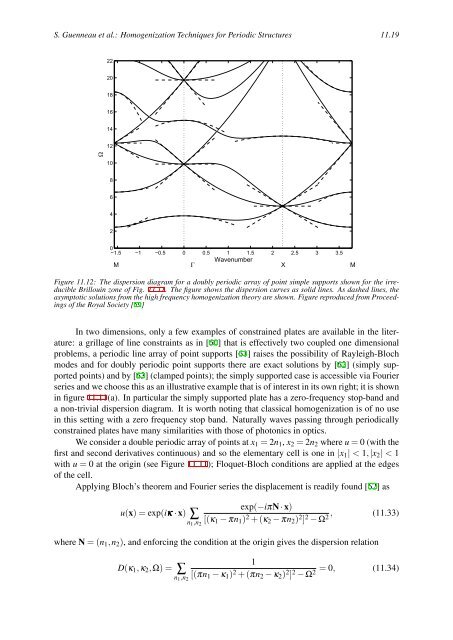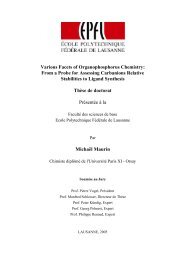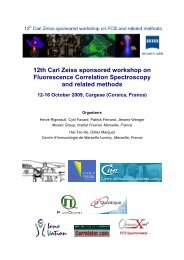GratinGs: theory and numeric applications - Institut Fresnel
GratinGs: theory and numeric applications - Institut Fresnel
GratinGs: theory and numeric applications - Institut Fresnel
You also want an ePaper? Increase the reach of your titles
YUMPU automatically turns print PDFs into web optimized ePapers that Google loves.
S. Guenneau et al.: Homogenization Techniques for Periodic Structures 11.19<br />
Ω<br />
22<br />
20<br />
18<br />
16<br />
14<br />
12<br />
10<br />
8<br />
6<br />
4<br />
2<br />
0<br />
−1.5 −1 −0.5 0 0.5 1 1.5 2 2.5 3 3.5<br />
M<br />
Γ<br />
Wavenumber<br />
X M<br />
Figure 11.12: The dispersion diagram for a doubly periodic array of point simple supports shown for the irreducible<br />
Brillouin zone of Fig. 11.11. The figure shows the dispersion curves as solid lines. As dashed lines, the<br />
asymptotic solutions from the high frequency homogenization <strong>theory</strong> are shown. Figure reproduced from Proceedings<br />
of the Royal Society [59]<br />
In two dimensions, only a few examples of constrained plates are available in the literature:<br />
a grillage of line constraints as in [60] that is effectively two coupled one dimensional<br />
problems, a periodic line array of point supports [61] raises the possibility of Rayleigh-Bloch<br />
modes <strong>and</strong> for doubly periodic point supports there are exact solutions by [62] (simply supported<br />
points) <strong>and</strong> by [63] (clamped points); the simply supported case is accessible via Fourier<br />
series <strong>and</strong> we choose this as an illustrative example that is of interest in its own right; it is shown<br />
in figure 11.11(a). In particular the simply supported plate has a zero-frequency stop-b<strong>and</strong> <strong>and</strong><br />
a non-trivial dispersion diagram. It is worth noting that classical homogenization is of no use<br />
in this setting with a zero frequency stop b<strong>and</strong>. Naturally waves passing through periodically<br />
constrained plates have many similarities with those of photonics in optics.<br />
We consider a double periodic array of points at x1 = 2n1, x2 = 2n2 where u = 0 (with the<br />
first <strong>and</strong> second derivatives continuous) <strong>and</strong> so the elementary cell is one in |x1| < 1,|x2| < 1<br />
with u = 0 at the origin (see Figure 11.11); Floquet-Bloch conditions are applied at the edges<br />
of the cell.<br />
Applying Bloch’s theorem <strong>and</strong> Fourier series the displacement is readily found [62] as<br />
exp(−iπN · x)<br />
u(x) = exp(iκκκ · x) ∑<br />
n1,n2<br />
[(κ1 − πn1) 2 + (κ2 − πn2) 2 ] 2 , (11.33)<br />
− Ω2 where N = (n1,n2), <strong>and</strong> enforcing the condition at the origin gives the dispersion relation<br />
D(κ1,κ2,Ω) = ∑<br />
n1,n2<br />
1<br />
[(πn1 − κ1) 2 + (πn2 − κ2) 2 ] 2 = 0, (11.34)<br />
− Ω2













